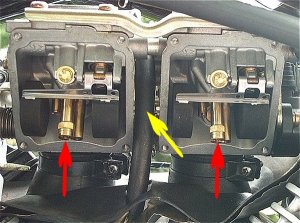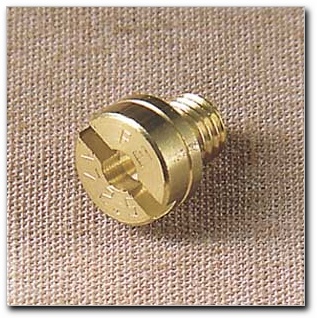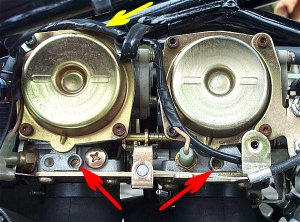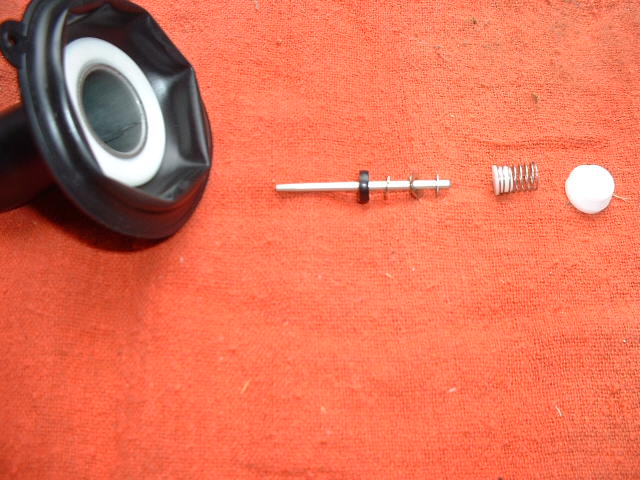The Theory behind re jetting the carb
|
This is a basic and easy way to try and understand why we do the things we do and the settings that we have you set your bike at. If your questions are not answered here than go to
|
|
 |
Pilot jets- This controls all of the Idle and the transition onto the needle circuit. So to allow the rest of the circuits to function properly We recommend never changing the pilot jets. You do not produce extra HP at idle . This is a good way to isolate the individual circuits of the carbs. Some companies send very large pilots with there air kits and do nothing about the needle circuit. They use the pilot circuit to try and compensate instead of spending money on needles. So there is pilot fuel throughout the fuel circuit but this is the wrong way to go about it.
The choke- The choke is used for cold starts and may be used as a diagnostic aid to check if your carbs are in a lean or rich state and help determine which carb circuits need adjustment. If while running you pull the choke out and the performance increases than it generally means your lean.
Mix screws- Idle and off idle is controlled by the mixture screws. Our bikes should be between 2.5 (factory recommendation for stock) and 3.5 turns out (from lightly seated) depending on pipes and air kit addition. |
|
Needles- The needle is designed to give the correct amount of fuel throughout the mid-range and we can adjust by shimming with #4 washers or move the circle clip from groove 1 to groove 6.
For our bikes, all of the air kits have the close to the same gains. With a slight advantage with the HC. 2 washers is equal to the 4th notch on the adjustable needles. This allows the correct amount of fuel for the extra air. The needles handle the rpm range from just off idle through 75% of the throttle. |
The left picture shows the needle shimmed with 2, #4 washers and the right shows the adjustable needles with the circle clip. The red arrow shows the tit on the needle spacer which you have to make sure that it is seated properly.
|
Now with the HC you get a little more air is forced in because of the ram air effect of the HC. If the HC is not pressurized you run the 5th notch of the adjustable needles. If pressurized the pressurization increases pressure to the float bowl to richen the fuel at the rate the air is increased into the carb through the HC ram
Not pressurized the air forced into the carb intake is higher in the venturi then the float bowl which allows more fuel and air mix. But with this you have the chance of a high gust of wind forcing more air into the HC and intake which make the bike run extremely lean and cut out. I compensate for this by aiming the float bowl vent hose forward so that any gust of wind that is high enough to lean out the mixture also is forced into the float bowls to compensate for this. You can mount this under the tank near the idle thumb screw and aimed forward. This method give the most performance gain and mpg but for those of you who ride in a lot of extreme conditions or a lot of highway miles pressurizing might be the best for you, but that is your choice on which way to go. The carb vent hose should be moved on every Air Kit except the RAK.
Main Jets- The main jets are responsible for fuel delivery at 3/4 throttle to wide open throttle and that point where the difference in extra air from the different type air kits greatly take effect, hence the different size main jets. Also the bike will run through about half throttle without even having the main jets installed. One again try to isolate the individual circuits for best performance.
The main Jets serves two functions ; static load and dynamic load.
The static load is the fuel received through the main jet in the upper gears, where the where the Rpm is increasing very slow.
The dynamic load of the main jet is the amount of fuel received from the jet in the low to mid-range gears when winding them out.
|
 Red arrows pointing at the main jets Red arrows pointing at the main jets |
 Mikuni main Jet |
Jetting example A good example is the RAK with Free flowing exhaust and 115mm Mikuni main jets, this gives you more top end but a loss in power in the low/mid range.
If you put 120mm Mikuni mains in then you get a great low/mid range and a lower top end.
Therefore you try to adjust the jet size to get a balance between low / midrange and top end. So now you use a 117.5 Mikuni Jet in most cases, to give you a middle of the road so to speak. This is why we list 3 different size jets in most cases in our recommendations for you to choose the jets for your type of driving. That is also why the larger main jet does not mean more top end and why some people have found that the bike doesn't reach the top end that it once did.
In a lot of cases we are told people get more top end out of a stock bike than a modified one. The 90mm main jets in a stock configuration caused the bike to run extremely lean and give it great top end but no low/midrange punch. Also that they had a great gain in low/midrange acceleration after pipes, air kit and re jet, but not as much top end. With proper jetting you can obtain both.
Syncing the carbs -Correct balancing of the carburetors ensures a smooth idle,and balances the engine throughout the rpm range. Therefore anytime you do anything to the carbs or pipes it is a good idea to re-sync the carbs it is very easy and can keep better performance and reduce vibrations. |
The left picture shows the needle shimmed with 2, #4 washers and the right shows the adjustable needles with the circle clip. The red arrow shows the tit on the needle spacer which you have to make sure that it is seated properly. |
Now with the HC you get a little more air is forced in because of the ram air effect of the HC. If the HC is not pressurized you run the 5th notch of the adjustable needles. If pressurized the pressurization increases pressure to the float bowl to richen the fuel at the rate the air is increased into the carb through the HC ram
Not pressurized the air forced into the carb intake is higher in the venturi then the float bowl which allows more fuel and air mix. But with this you have the chance of a high gust of wind forcing more air into the HC and intake which make the bike run extremely lean and cut out. I compensate for this by aiming the float bowl vent hose forward so that any gust of wind that is high enough to lean out the mixture also is forced into the float bowls to compensate for this. You can mount this under the tank near the idle thumb screw and aimed forward. This method give the most performance gain and mpg but for those of you who ride in a lot of extreme conditions or a lot of highway miles pressurizing might be the best for you, but that is your choice on which way to go. The carb vent hose should be moved on every Air Kit except the RAK.
Main Jets- The main jets are responsible for fuel delivery at 3/4 throttle to wide open throttle and that point where the difference in extra air from the different type air kits greatly take effect, hence the different size main jets. Also the bike will run through about half throttle without even having the main jets installed. One again try to isolate the individual circuits for best performance.
The main Jets serves two functions ; static load and dynamic load.
The static load is the fuel received through the main jet in the upper gears, where the where the Rpm is increasing very slow.
The dynamic load of the main jet is the amount of fuel received from the jet in the low to mid-range gears when winding them out. |
|
Jetting example
A good example is the RAK with Free flowing exhaust and 115mm Mikuni main jets, this gives you more top end but a loss in power in the low/mid range.
If you put 120mm Mikuni mains in then you get a great low/mid range and a lower top end.
Therefore you try to adjust the jet size to get a balance between low / midrange and top end. So now you use a 117.5 Mikuni Jet in most cases, to give you a middle of the road so to speak. This is why we list 3 different size jets in most cases in our recommendations for you to choose the jets for your type of driving. That is also why the larger main jet does not mean more top end and why some people have found that the bike doesn't reach the top end that it once did.
In a lot of cases we are told people get more top end out of a stock bike than a modified one. The 90mm main jets in a stock configuration caused the bike to run extremely lean and give it great top end but no low/midrange punch. Also that they had a great gain in low/midrange acceleration after pipes, air kit and re jet, but not as much top end. With proper jetting you can obtain both.
Syncing the carbs -Correct balancing of the carburetors ensures a smooth idle,and balances the engine throughout the rpm range. Therefore anytime you do anything to the carbs or pipes it is a good idea to re-sync the carbs it is very easy and can keep better performance and reduce vibrations. |
| |



.jpg)
 Red arrows pointing at the main jets
Red arrows pointing at the main jets Mikuni main Jet
Mikuni main Jet